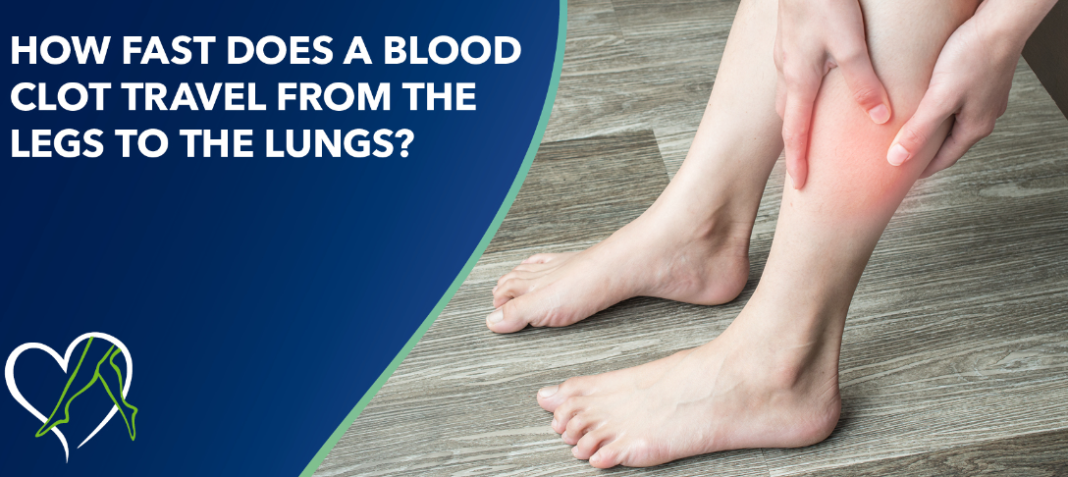BOURSESSENEGAL – Blood clots can pose serious health risks, particularly when they move from one part of the body to another. One common concern is, how fast does a blood clot travel from the leg to the lungs? Knowing the answer to this question can help you understand the urgency of treating blood clots and the importance of recognizing their symptoms.
What Is a Blood Clot?
A blood clot forms when blood cells stick together to stop bleeding. This process is essential for healing injuries. However, sometimes clots form inappropriately, especially in the legs. These clots can travel through the bloodstream, potentially reaching vital organs like the lungs, leading to conditions such as pulmonary embolism.
Types of Blood Clots
Understanding blood clots involves recognizing the different types:
- Deep Vein Thrombosis (DVT): This type occurs in deep veins, commonly in the legs.
- Pulmonary Embolism (PE): This happens when a DVT clot travels to the lungs, blocking blood flow.
Why Do Clots Form?
Several factors contribute to clot formation. These include prolonged immobility, certain medical conditions, and lifestyle choices. For example, sitting for long periods, as during long flights, increases the risk of developing DVT.
The Journey of a Blood Clot
Now, let’s address the central question: how fast does a blood clot travel from the leg to the lungs? The speed at which a clot moves varies based on several factors, including blood flow and the size of the clot.
Blood Flow Dynamics
When a clot forms in the leg, it may travel through the venous system. The veins return deoxygenated blood to the heart. From there, blood pumps into the lungs for oxygenation. Under normal circumstances, this journey can take just a few minutes. However, if a clot is large or if blood flow is restricted, the journey might take longer or result in serious complications.
Factors Influencing Speed
Several factors influence how quickly a clot can travel:
- Clot Size: Larger clots may cause more obstruction and may move slower.
- Blood Flow Rate: Faster blood flow can speed up the movement of the clot.
- Individual Health: Conditions like heart health and circulation can impact clot travel speed.
Estimated Timeframe
In general, if a clot detaches from the leg and enters the bloodstream, it can reach the lungs within 5 to 30 minutes. However, this timeframe can vary. Early intervention is crucial, as recognizing symptoms can save lives.
Recognizing Symptoms of Blood Clots
Knowing the symptoms of DVT and PE can help you act quickly:
Symptoms of Deep Vein Thrombosis (DVT)
- Swelling in one leg
- Pain or tenderness
- Warmth in the affected area
- Discoloration
Symptoms of Pulmonary Embolism (PE)
- Sudden shortness of breath
- Chest pain
- Rapid heartbeat
- Coughing up blood
If you experience any of these symptoms, seek medical attention immediately.
Treatment Options for Blood Clots
If a doctor diagnoses a blood clot, treatment typically involves anticoagulants. These medications thin the blood, preventing further clotting and helping the body dissolve existing clots.
Common Medications
- Heparin: Often administered in hospitals for immediate effect.
- Warfarin: An oral anticoagulant used for long-term treatment.
- Direct Oral Anticoagulants (DOACs): These newer medications provide easier management without regular blood testing.
Lifestyle Changes
In addition to medication, making lifestyle changes can help prevent future clots:
- Stay active and avoid prolonged immobility.
- Maintain a healthy weight.
- Stay hydrated.
- Wear compression stockings if recommended.
Conclusion: The Importance of Awareness
Understanding how fast does a blood clot travel from the leg to the lungs is crucial for recognizing the urgency of the situation. Awareness of symptoms and risk factors can lead to timely medical intervention, reducing the risk of serious complications like pulmonary embolism.
Always consult a healthcare provider for personalized advice and recommendations. Staying informed and proactive about your health can make a significant difference.
Final Thoughts
In summary, blood clots can travel swiftly, and recognizing the signs can save your life. Stay informed about your body, and don’t hesitate to seek help if something feels off. Your health is paramount, and understanding these concepts is a key part of maintaining it.
REFERENCE : https://www.health.com/



